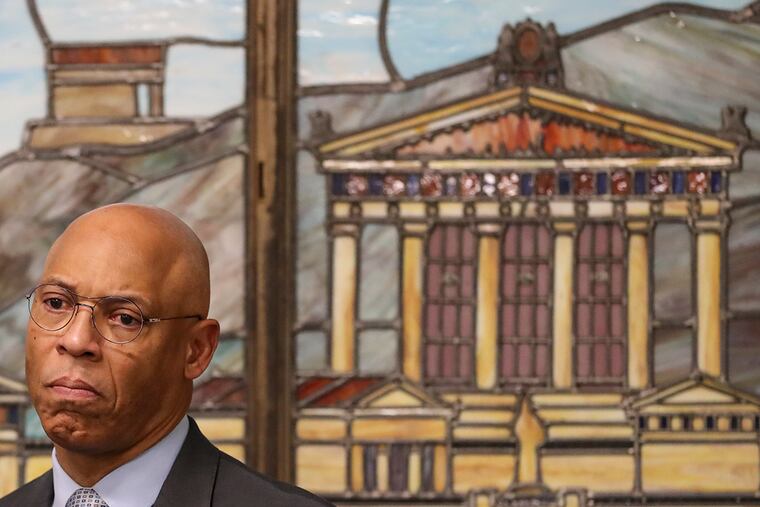Asbestos closes two more Philly schools, the 5th and 6th so far this year
“The toxic conditions at our school, though repeatedly ignored by the school district, are no mystery to those of us who endure them each day,” a group of Philadelphia teachers wrote.

Two more Philadelphia School District buildings were closed on Friday because of “imminent hazards” caused by damaged asbestos.
The announcements about McClure and Carnell Elementaries, made late Thursday night, underscored the burgeoning environmental crisis the district now has on its hands.
Soon after the school year began, damaged asbestos forced the relocation of students from Benjamin Franklin High and Science Leadership Academy. Next, students were removed from T.M. Peirce Elementary. On Tuesday, Franklin Learning Center was ordered closed.
The decision to shut McClure, at Sixth and Hunting Park, was made first; soon after, district officials announced Carnell, where “several imminent hazards” were found, would also need to shut.
“The School District of Philadelphia’s top priority remains to provide a healthy, safe and welcoming learning environment for all students and staff," spokesperson Megan Lello said in a statement.
Lello said the decisions to close were made “out of an abundance of caution.”
On Wednesday night, an environmental firm hired by the district found asbestos in Carnell’s first-floor hallway, third-floor women’s restroom, third-floor custodial closet, and third-floor storage room that was so damaged, immediate action needed to be taken.
District officials alerted the Philadelphia Federation of Teachers about Carnell Thursday morning and Jerry Roseman, the union’s environmental science director, soon followed up with a visit. Roseman found additional areas of similar damage.
The Carnell principal and custodial assistant told him the areas of damaged asbestos, including severely cracked pipe insulation, had been in that condition for at least eight years.
“The people in the building were a little bit freaked,” Roseman said.
» READ MORE: Missed asbestos, dangerous dust: How Philadelphia’s Ben Franklin H.S. project went wrong
In room 108 and the room’s closet, Roseman found asbestos-wrapped pipes with holes, cracks, and tears; and yet, the district’s environmental inspector had failed to flag the conditions as imminent hazards, Roseman said. Teachers told him that there are three rooms on each floor with pipe insulation that appears in similar shape as in room 108.
“The conditions are prevalent,” Roseman said.
Later on Thursday, Roseman went to McClure to meet up with Brian Joseph, the district’s environmental manager, to discuss asbestos concerns expressed by staff, including teachers and the principal. Roseman and Joseph were there to talk about the federally mandated inspections that the district is required to do every three years and to talk to teachers about how to interpret those reports.
But during the McClure meeting, staff members asked Roseman and Joseph to walk through the building with them to address concerns.
They spent almost four hours at the school as Thursday afternoon turned into night.
“We identified 10 areas of damaged asbestos, half of which were considered imminent hazards,” Roseman said. He recommended that the areas identified be isolated and closed off and that more aggressive testing and evaluation be done before further occupancy was allowed.
When in good condition, asbestos is not considered a health hazard, but when the material is damaged, especially crumbling, tiny cancer-causing fibers can get released into the air and inhaled.
Under federal law, the district must hire outside environmental firms to inspect buildings for asbestos, noting its location and condition, every three years. The law requires a less stringent visual walkthrough of the school every six months. Carnell was thoroughly inspected for asbestos about a year ago and McClure had its most recent three-year inspection in 2016.
While Roseman inspected McClure, teachers from Franklin Learning Center marched to the school system’s North Broad Street headquarters to deliver a letter to Superintendent William R. Hite Jr. and the school board demanding the district fully remediate the school, which staff and students have said for years contains multiple environmental hazards.
“Our students and staff work hard every day to make FLC the award-winning school it is, but due to the negligence of the school district, we are paying for it with our health,” the teachers wrote. “We have seen staff and students develop new cases of asthma, allergies, breast cancer, lymphoma, brain tumors and autoimmune disorders at elevated rates. The toxic conditions at our school, though repeatedly ignored by the school district, are no mystery to those of us who endure them each day.”
FLC students walked out over asbestos in the building in the 1990s. Teachers have routinely reported the problems they see in their school on North 15th Street.
“These reports were overwhelmingly unanswered,” the teachers said.
Jerry Jordan, the PFT president, said 1,596 environmental concerns have been reported to the union through an app it developed to keep track of such problems.
What’s needed, Jordan said, is “structural change to district operations in how they approach the facilities catastrophe unfolding in our schools.”